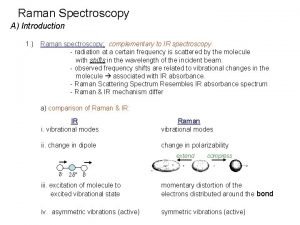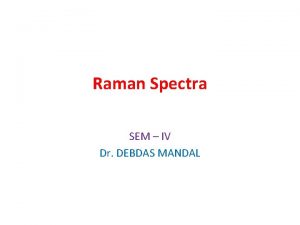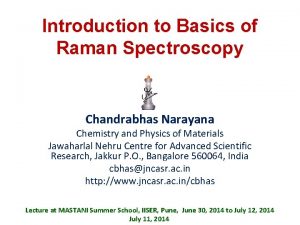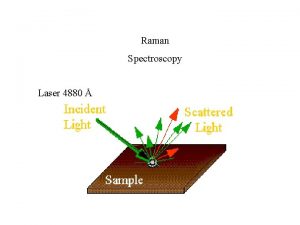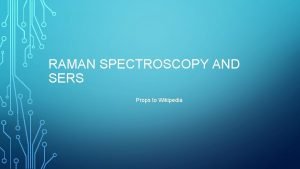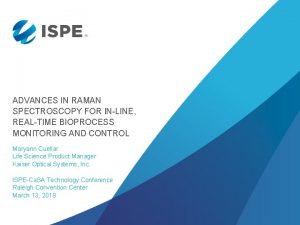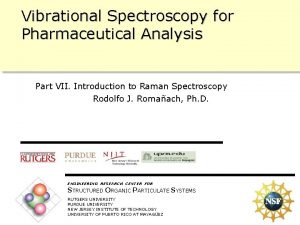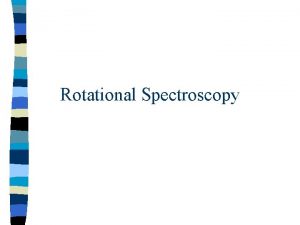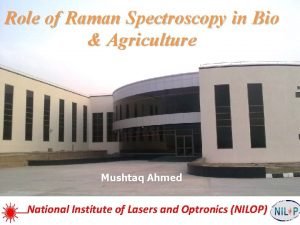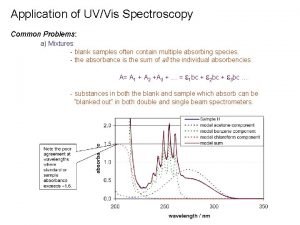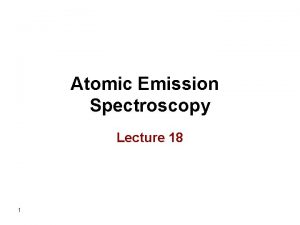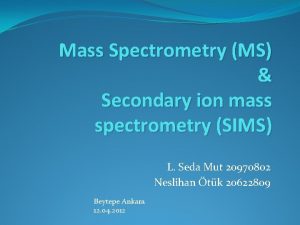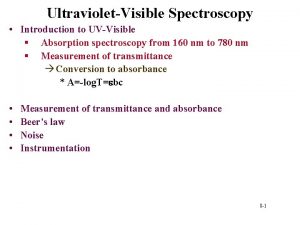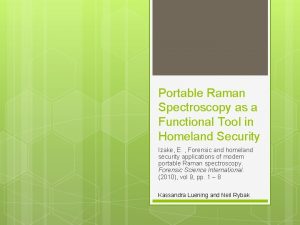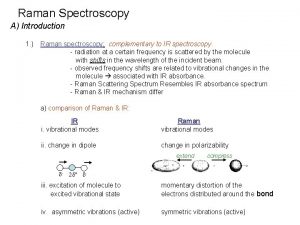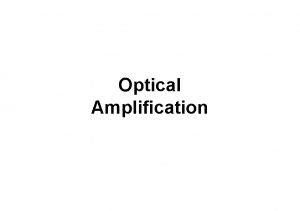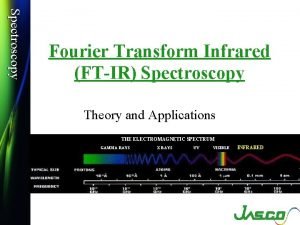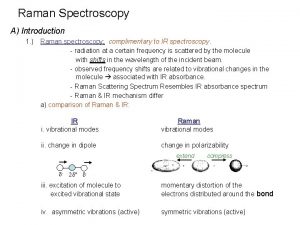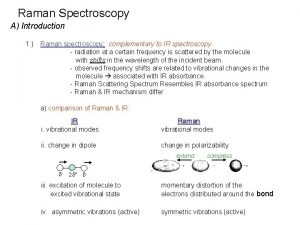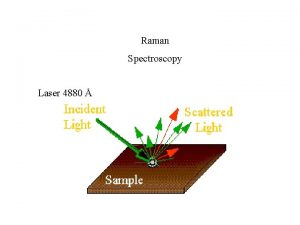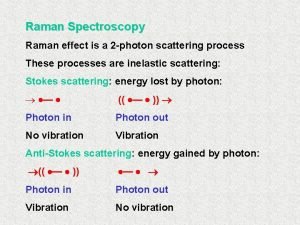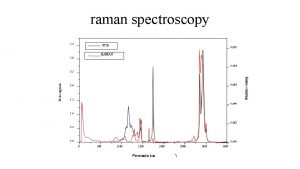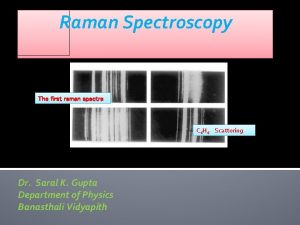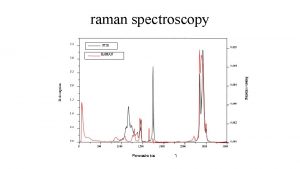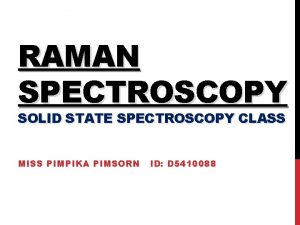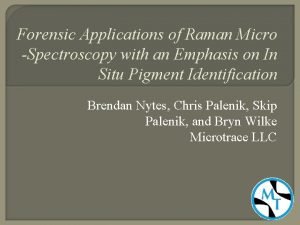m RAMAN Introduction and Applications in Raman Spectroscopy




















- Slides: 20

m. RAMAN Introduction and Applications in Raman Spectroscopy Aaron Celestian

Uses of Raman Spectroscopy • Finger printing of compounds • Crystalline or non-crystalline • All materials have different Raman spectrums • Fast • Data can be obtained in less than one second • Mostly non-destructive • Ease of Use • “Point-and-Shot” analysis • No sample preparation • Laser spot sizes down to 1 micron or less

Examples • Pigment Analysis • contact your art department • Compositional Mapping • Phenocryst zoning analysis • Fluid inclusion analysis • Presence of N 2, CO 2, CH 4, H 2 O • Density of CO 2 (European Journal of Mineralogy 2008; DOI: 10. 1127/09351221/2008/0020 -1825) • Monitor mineralogical processes

Thermo DXR Dispersive Raman Microscope Rigakuraman. com

4. 00 E+04 What information is in the spectrum? 3. 50 E+04 3. 00 E+04 External Modes • Rigid units Region of External Modes Internal Modes • Internal polyhedral bonds Intensity (cps) 2. 50 E+04 2. 00 E+04 1. 50 E+04 1. 00 E+04 5. 00 E+03 0. 00 E+00 0 200 400 600 800 Raman Shift (cm-1) 1000 1200 1400

40000 What information is in the spectrum? • Look up frequencies in a database • Chemical components • • CO 3 CO 2 Si. O 4 Pattern of peak positions can identify compound 30000 Intensity (cps) Characteristic Raman frequencies tell you the composition of the materials. 35000 20000 15000 10000 5000 0 800 820 840 860 Raman Shift (cm-1) 880 900

40000 What information is in the spectrum? 35000 Shifts in peak position: • • Stress / strain Changes in composition can induced stress Intensity (cps) 30000 25000 20000 15000 10000 5000 0 800 820 840 860 Raman Shift (cm-1) 880 900

What information is in the spectrum? • • Stress / strain state Quality of the crystal – degree of molecular order 35000 Intensity (cps) Width of the peak: 40000 30000 25000 20000 15000 10000 5000 0 800 820 840 860 880 Raman Shift (cm-1) 900

4. 00 E+04 What information is in the spectrum? 3. 50 E+04 3. 00 E+04 • • Crystal-Laser polarization directions Amount of material being probed (thickness of sample) Intensity (cps) Change in intensity can be due to: Parallel to Polarization Direction Perpendicular to Polarization Direction 2. 50 E+04 2. 00 E+04 1. 50 E+04 1. 00 E+04 5. 00 E+03 0. 00 E+00 1020 1040 1060 Raman Shift (cm-1) 1080 1100

Search and Match • Commercial Software • Usually comes with the instrument • Usually have to pay for the databases • Usually do not contain minerals • Crystal. Sleuth (Robert Downs) • Free (http: //rruff. info/) • Contains only minerals Show search-match with an ‘unknown 1’ Show search-match with an ‘unknown 2’

Zoned Alkali Feldspars Albite – Anorthite Elaine Flynn (S) and Andrew Wulff (P) mined data from the RRUFF database Plot peak position as a function of composition Data from RRUFF and Freeman et al. (2008) CHARACTERIZATION OF NATURAL FELDSPARS BY RAMAN SPECTROSCOPY FOR FUTURE PLANETARY EXPLORATION The Canadian Mineralogist Vol. 46, pp. 1477 -1500 DOI : 10. 3749/canmin. 46. 6. 1477 Triangles = plag series Squares = Orthoclase Asterisks = Ternary Feldspars X = unknown

Data from Bischoff, Sharma, and Mackenzie (1985) American Mineralogist, 70, 581 -589

100 x Tufa Barstow, CA Organic Layers Calcite Layers • Crystal Fabrics • Growth Patterns Trace Minerals 500 x

(Dickson slide #107 -41) Raman Map of Crinoid Stem Darker blues are the stereom and lighter blues, yellows, and reds are the skeletal framework. Intensity variations in this map just show where there is more calcite than in other areas. Skeletal Framework ~3 mol% Mg. CO 3

Close to the center of the channel, there isn’t much change with respect to Mg increase. Only a few mol %. ~2. 3(1) mol% Mg. CO 3 ~3. 0(1) mol% Mg. CO 3 There is a very little difference in the peak position within the ambulacra and outside ambulacra ~2. 3(1) mol% Mg. CO 3 Reflected Light Extracted line profile from Raman Map This correlates with the start and stop of the ambulacral grooves (roughly outlined in yellow by hand)

Ion Exchange • Zeolites and micro-porous molecular • Watch reactions taking place in real time • In Class Exercises: • Use of various natural and synthetic microporous structures • Nuclear waste sequestration (Cs and Sr) • Water softening • NH 4 removal

Experimental Setup for In Situ Raman Studies

Time Resolved K Na-NAT Time resolved data of K exchange into Nanatrolite. Note the two different exchange steps. 1. A decrease in peak intensity 2. Shift in peak position to lower wavenumbers

Home built ITTFA Estimated Peak Evolution Intensity Softening of the 8 MR Green = Na-NAT Blue = K-NAT 8 MR changes to more circular Frame number relative to frame 76 Intensity Shift Estimated Pure Spectra Based on a Two Component ITTFA X position This is the Iterative Targeted Transformation Factor Analysis which helps determine when changes are occurring in the spectra. Students still to do peak fitting and EPE deconvolution.

Summary of Raman • Non destructive • Fast • Little to no sample preparation • Experiments to accompany structural studies • Leaves students with a new tool and encourage undergraduate research
 Why are raman and ir complementary
Why are raman and ir complementary Difference between ir and raman spectroscopy
Difference between ir and raman spectroscopy Low na
Low na Raman spectroscopy selection rules
Raman spectroscopy selection rules Sers wiki
Sers wiki Use of raman spectroscopy
Use of raman spectroscopy Inline raman spectroscopy
Inline raman spectroscopy Raman spectroscopy disadvantages
Raman spectroscopy disadvantages Non rigid rotator
Non rigid rotator Terahertz spectroscopy principles and applications
Terahertz spectroscopy principles and applications Applications of uv and visible spectroscopy
Applications of uv and visible spectroscopy Applications of raman effect in daily life
Applications of raman effect in daily life Effect of solvent polarity on uv absorption
Effect of solvent polarity on uv absorption Flame photometry instrumentation
Flame photometry instrumentation Applications of mass spectrometry
Applications of mass spectrometry Charge d'un électron
Charge d'un électron Portable raman analyzer for hazmat and narcotics
Portable raman analyzer for hazmat and narcotics Why are raman and ir complementary
Why are raman and ir complementary Edfa gain spectrum
Edfa gain spectrum Management myths in software engineering
Management myths in software engineering Definition of ir spectroscopy
Definition of ir spectroscopy
